Nuclear Industry Performance
Global highlights
Nuclear reactors generated a total of 2653 TWh in 2021, up 100 TWh from 2553 TWh in 2020. This is the third highest ever total for global generation from nuclear, just short of the 2657 TWh output of 2019 and 2660 TWh in 2006, and reestablishes the upward trend in nuclear generation seen since 2012, following a decline in 2020.
Figure 1. Nuclear electricity production
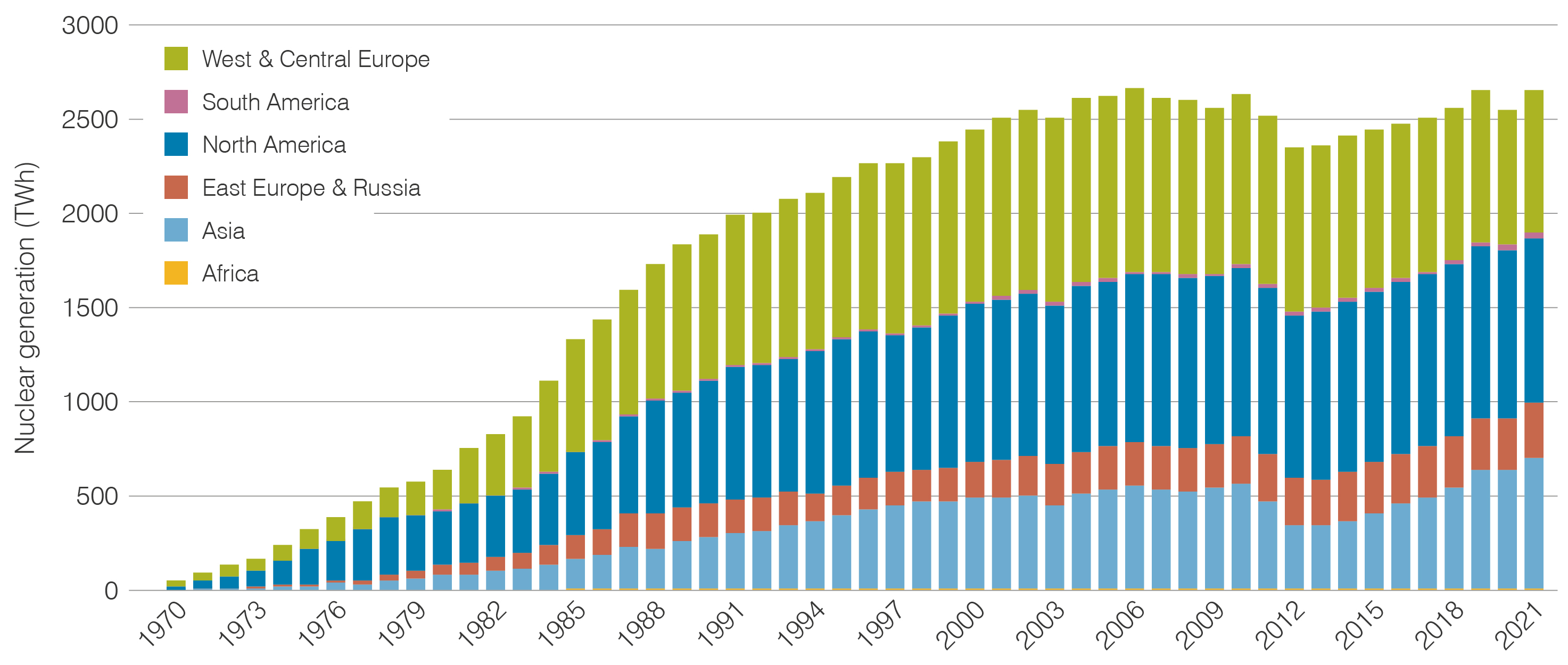
Source: World Nuclear Association and IAEA Power Reactor Information Service
In 2021 nuclear generation increased in Africa, Asia, East Europe & Russia, and in South America. These increases continued upward trends seen in recent years in those regions. Generation also increased in West and Central Europe, but in this region the overall trend remains downward. Generation declined for the second year running in North America as more reactors in the USA were closed.
Figure 2. Regional generation
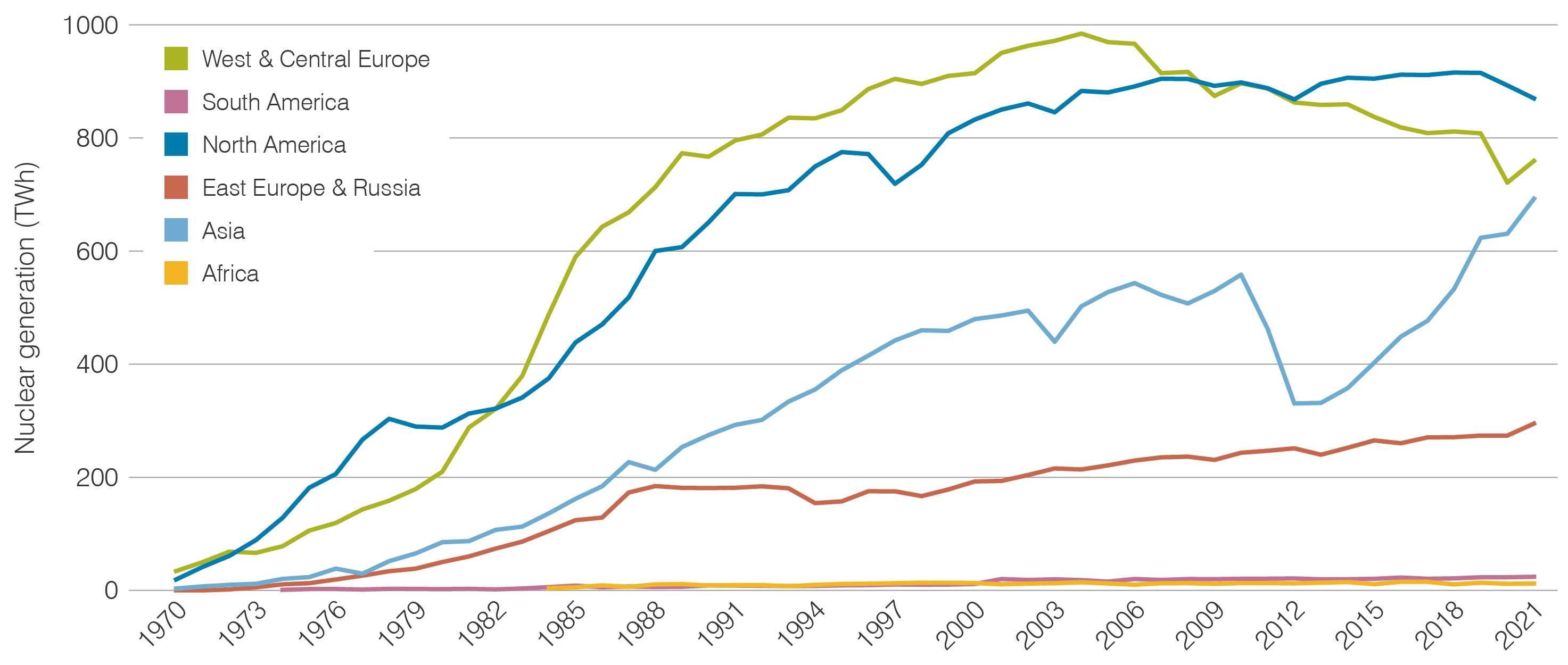
Source: World Nuclear Association and IAEA Power Reactor Information Service
In 2021 the end of year capacity of operable nuclear power plants was 396 GWe, down 1 GWe on 2020.The total capacity of reactors producing electricity in 2021 was 370 GWe, up 1 GWe from 2020. This is the highest ever total capacity of reactors generating electricity in one year.
In most years, a small number of operable reactors do not generate electricity. In recent years the figure has been higher, as reactors in Japan await approval to restart following the Fukushima Daiichi accident in 2011. As some Japanese reactors have now restarted, and others have been permanently shut down, the total number of reactors operable, but not generating, has gradually reduced.
Figure 3. Nuclear generation capacity operable (net)
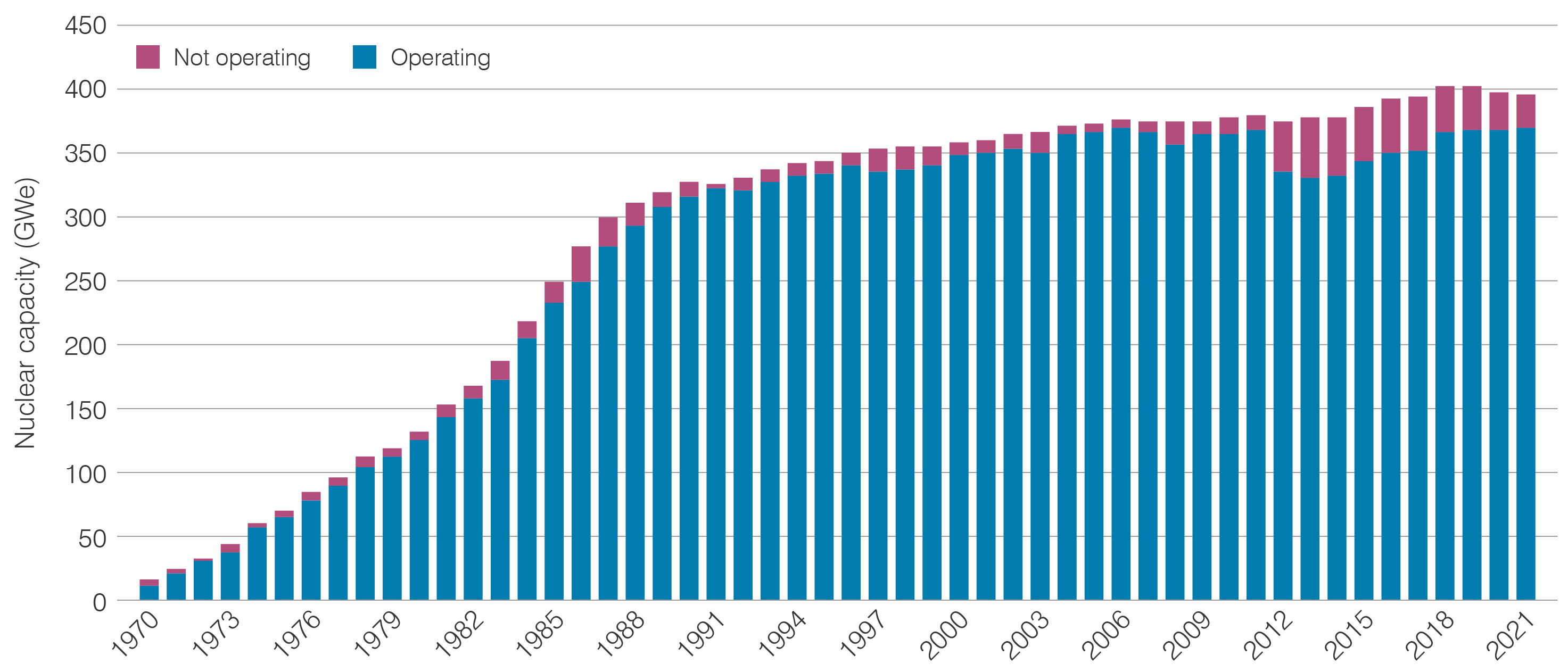
Source: World Nuclear Association, IAEA PRIS
Although the end of year capacity of operable reactors was up in 2021, the total number of reactors was 436, down five on 2020. Nearly 70% of all operable reactors are pressurized water reactors (PWRs), with all except one of the 34 reactors that have started up between 2017 and 2021 being PWRs.
Table 1. Operable nuclear power reactors at year-end 2021
| |
Africa
|
Asia
|
East Europe & Russia
|
North America
|
South America
|
West & Central Europe
|
Total
|
|
BWR
|
|
20
|
|
33 |
|
8
|
61
|
|
FNR
|
|
|
2
|
|
|
|
2
|
|
GCR
|
|
|
|
|
|
11
|
11
|
|
HTGR
|
|
1
|
|
|
|
|
1
|
|
LWGR
|
|
|
11
|
|
|
|
11
|
|
PHWR
|
|
24
|
|
19 |
3 |
2
|
48
|
|
PWR
|
2
|
99
|
40
|
61 |
2 |
98
|
302
|
|
Total
|
2
|
144
|
53
|
113 |
5 |
119
|
436
|
Operational performance
Capacity factors in this section are based on the performance of those reactors reporting electricity generation during each calendar year. In 2021 the global average capacity factor was 82.4%, up from 80.3% in 2020. This continues the trend of high global capacity factors seen since 2000.
Figure 4. Global average capacity factor

Source: World Nuclear Association, IAEA PRIS
Capacity factors for different reactor types in 2021 were broadly consistent with those achieved in the previous five years. The UK's AGRs currently represent the entirety of the gas-cooled reactor category, and all are expected to have shut down by the end of the 2020s.
Figure 5. Capacity factor by reactor type
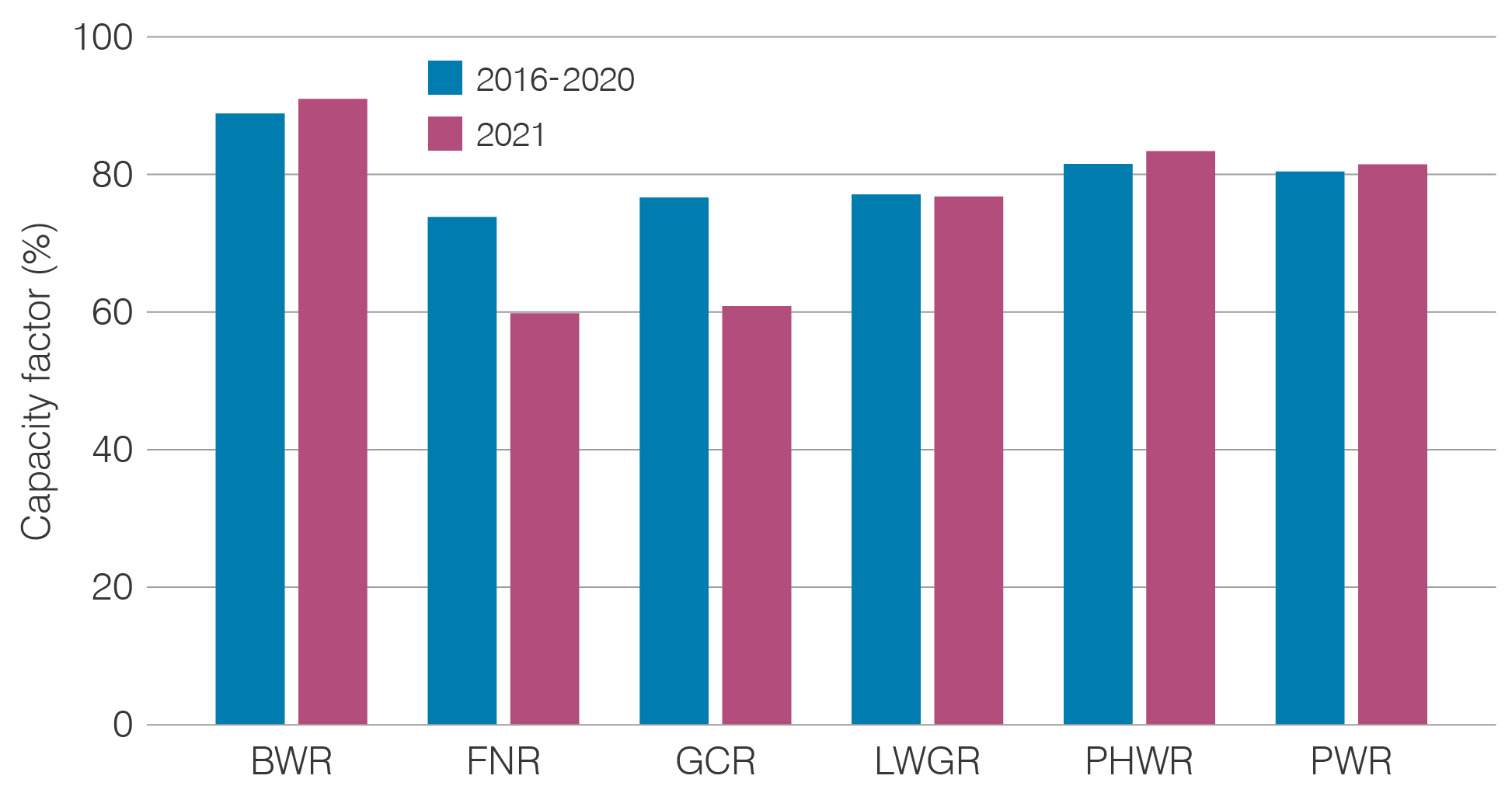
Source: World Nuclear Association, IAEA PRIS
Capacity factors in 2021 for reactors in different geographical regions were also broadly consistent with the average achieved in the previous five years, with North America maintaining the highest average capacity factors.
Figure 6. Capacity factor by region
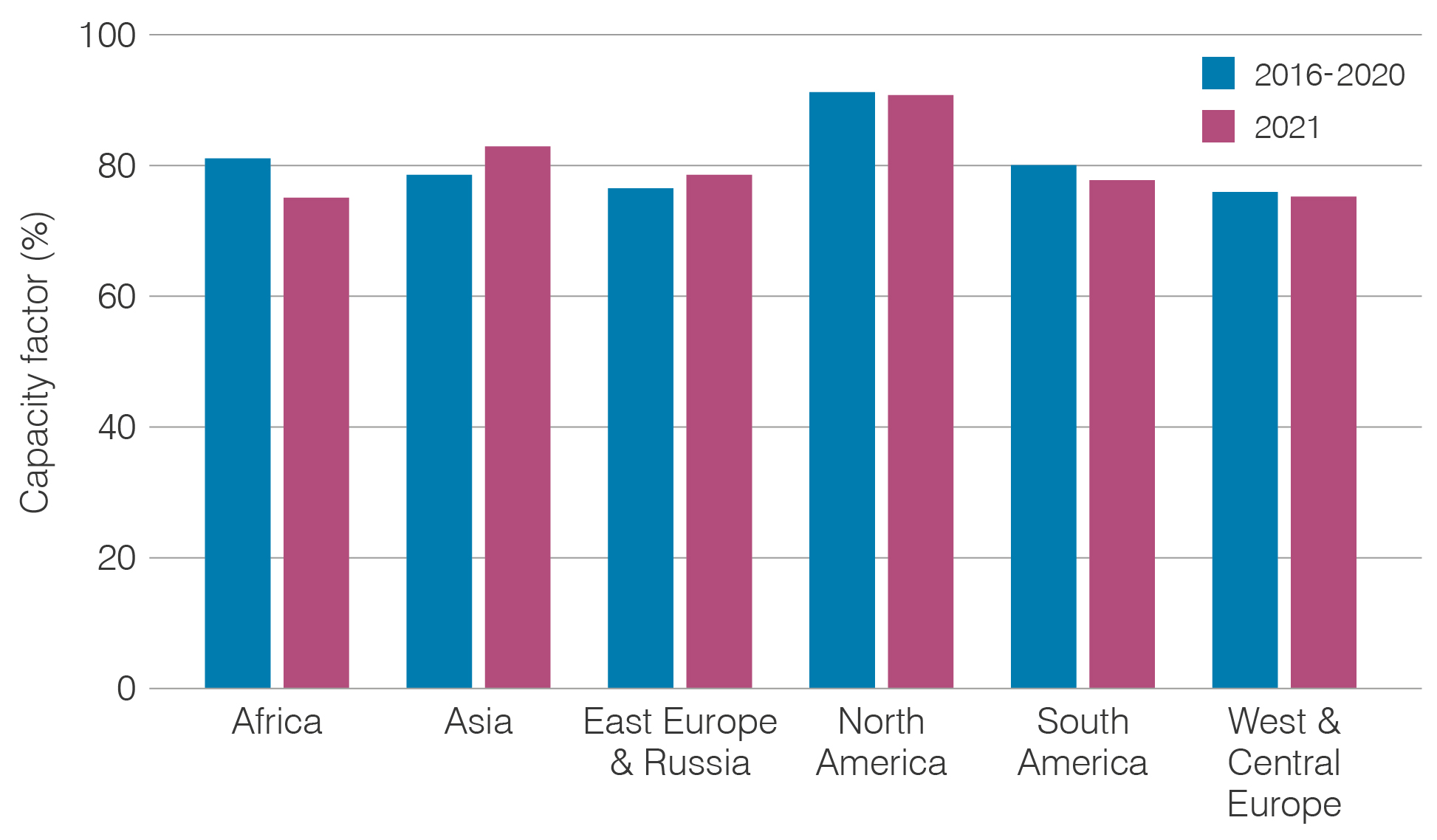
Source: World Nuclear Association, IAEA PRIS
There is no age-related decline in nuclear reactor performance. The mean capacity factor for reactors over the last five years shows no significant overall variation with age. Improvements in average global capacity factors have been achieved in reactors of all ages, not just new reactors of more advanced designs.
Figure 7. Mean capacity factor 2017-2021 by age of reactor
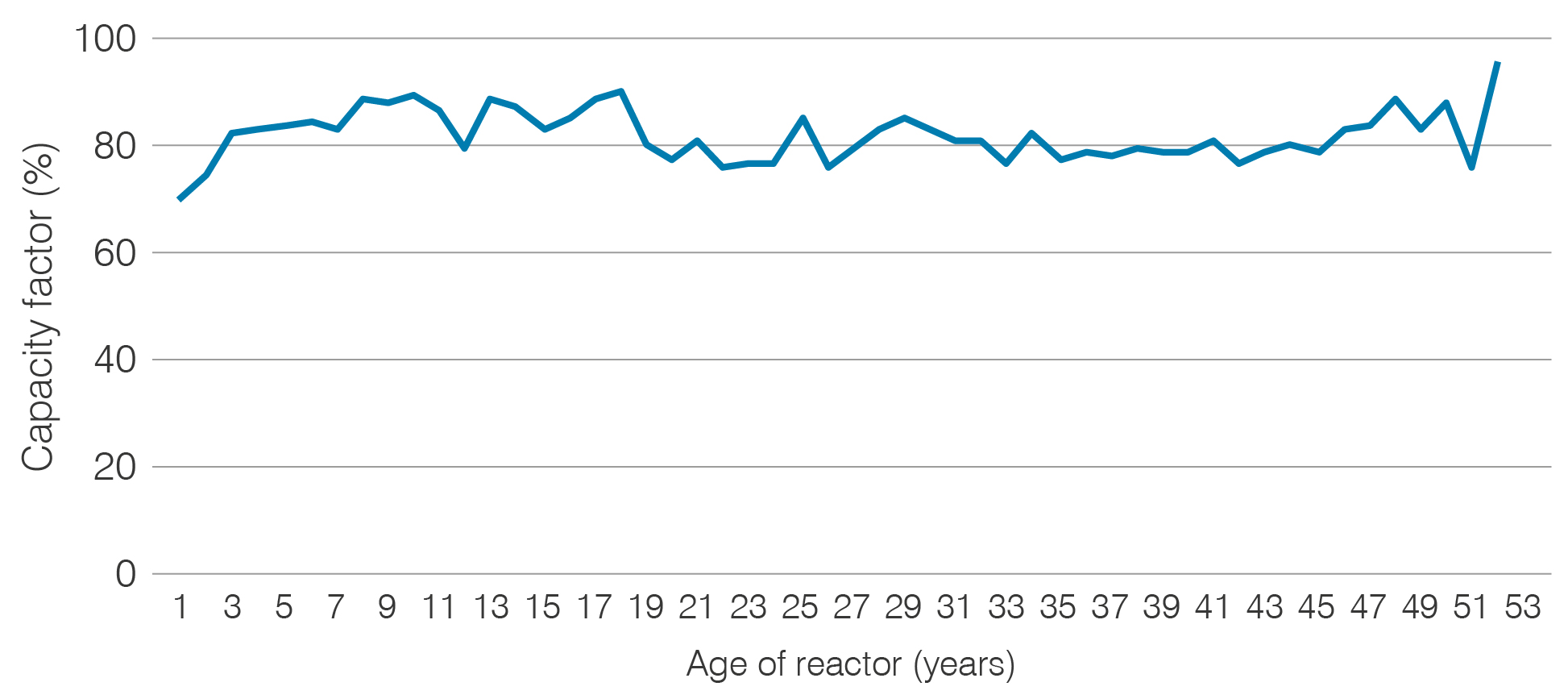
Source: World Nuclear Association, IAEA PRIS
The spread of capacity factors in 2021 is broadly similar to the average of the previous five years. Just over two-thirds of reactors have a capacity factor greater than 75%.
Figure 8. Percentage of units by capacity factor
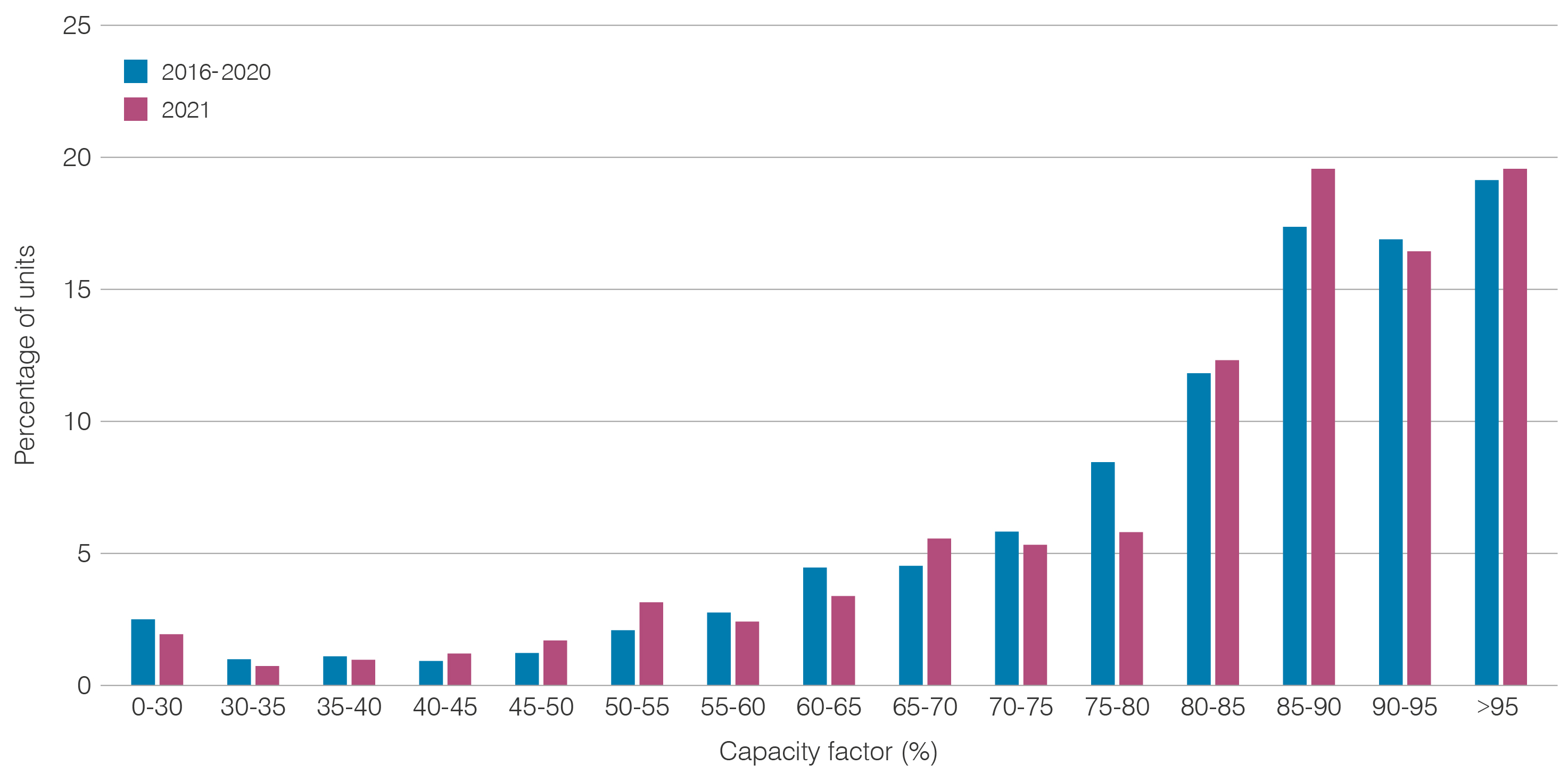
Source: World Nuclear Association, IAEA PRIS
A steady improvement in reactor performance can be seen in the following chart, which presents the average capacity factors in each decade since the 1970s, as well as for 2020 and 2021.
Figure 9. Long-term trends in capacity factors
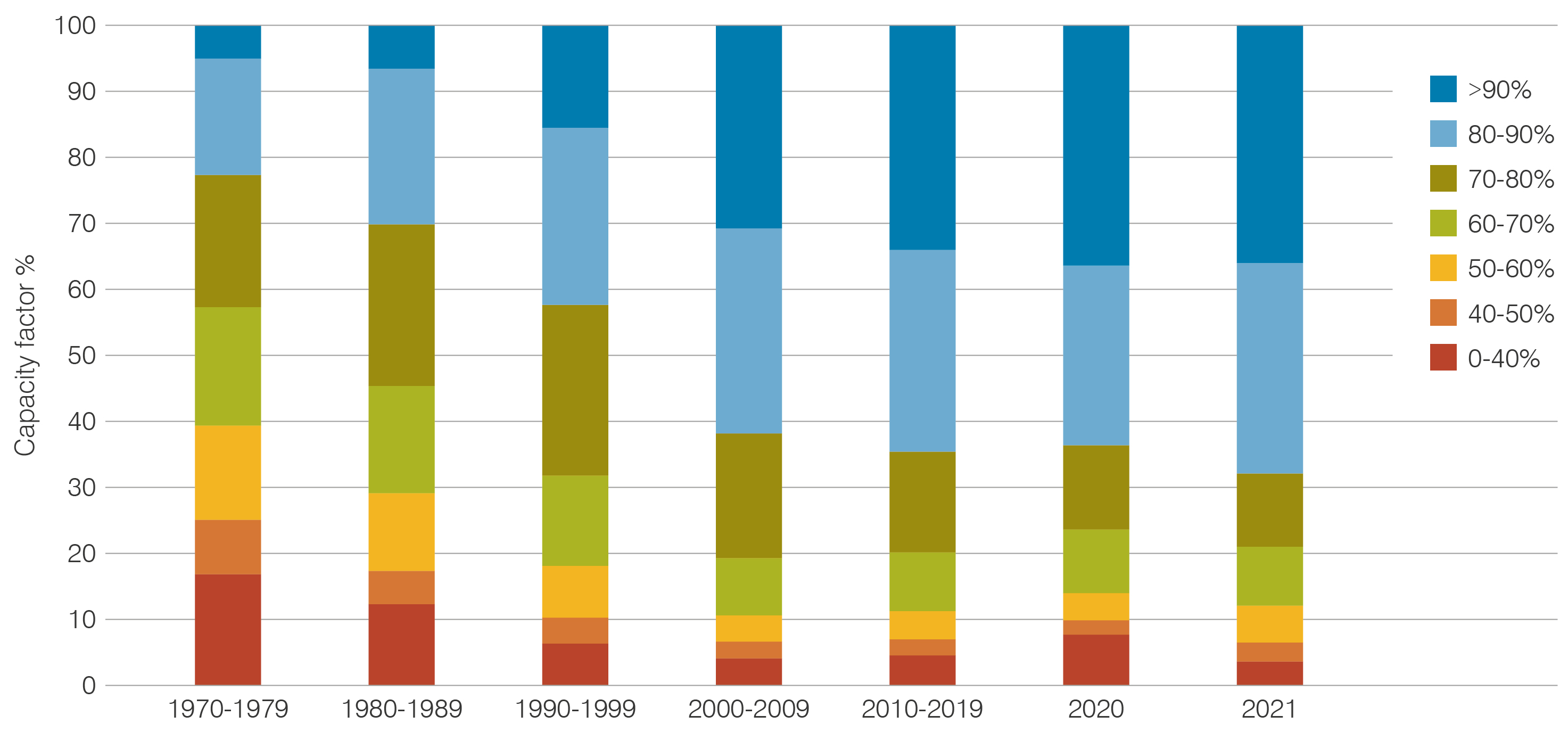
Source: World Nuclear Association, IAEA PRIS
New construction
Alongside eight large PWRs, in 2021 construction began on a lead-cooled fast reactor at Seversk, near Tomsk in Russia and a small modular reactor at Changjiang, in the province of Haiyang in China.
Table 2. Reactor construction starts in 2021
| |
Location |
Model |
Design net capacity (MWe) |
Construction start date |
|
Akkuyu 3
|
Turkey
|
VVER V-509
|
1114
|
10 March 2021
|
|
Changjiang 3
|
China
|
HPR1000
|
1100
|
31 March 2021
|
|
Tianwan 7
|
China
|
VVER V-491
|
1100
|
19 May 2021
|
|
Seversk
|
Russia
|
BREST-OD-300
|
300
|
8 June 2021
|
|
Kudankulam 5
|
India
|
VVER V-412
|
917
|
29 June 2021
|
|
Changjiang SMR
|
China
|
ACP100
|
100
|
13 July 2021
|
|
Xudabao 3
|
China
|
VVER V-491
|
1100
|
28 July 2021
|
|
Kudankulam 6
|
India
|
VVER V-412
|
917
|
20 December 2021
|
|
Changjiang 4
|
China
|
HPR1000
|
1100
|
28 December 2021
|
|
San'ao 2
|
China
|
HPR1000
|
1117
|
31 December 2021
|
Source: World Nuclear Association, IAEA PRIS
With ten construction starts and six reactors connected to the grid, the total number of units under construction at the end of 2021 was 53, four more than at the end of 2020.
Table 3. Units under construction by region year-end 2021
|
|
BWR
|
FNR
|
HTGR
|
PHWR
|
PWR
|
Total
|
|
Asia
|
2
|
2
|
0
|
3
|
29
|
36
|
|
East Europe & Russia
|
|
1
|
|
|
6
|
7
|
|
North America
|
|
|
|
|
2
|
2
|
|
South America
|
|
|
|
|
2
|
2
|
|
West & Central Europe
|
|
|
|
|
6
|
6
|
|
Total
|
2
|
3
|
|
3
|
45
|
53
|
Source: World Nuclear Association, IAEA PRIS
Six reactors were connected to the grid for the first time in 2021. Shandong Shidaowan is a notable new start as it consists of two 250 MWt high-temperature reactor pebble-bed modules (HTR-PM) connected to a single 200 MWe steam turbine. Future larger plants would be based on larger numbers of HTR-PM modules.
Table 4. Reactor grid connections in 2021
|
|
Location
|
Capacity (MWe net)
|
Construction start
|
First grid connection
|
|
Kakrapar 3
|
India
|
630
|
22 November 2010
|
10 January 2021
|
|
Karachi 2
|
Pakistan
|
1014
|
20 August 2015
|
18 March 2021
|
|
Tianwan 6
|
China
|
1060
|
7 September 2016
|
11 May 2021
|
|
Hongyanhe 5
|
China
|
1061
|
29 March 2015
|
25 June 2021
|
|
Barakah 2
|
United Arab Emirates
|
1345
|
15 April 2013
|
14 September 2021
|
|
Shandong Shidaowan
|
China
|
200
|
9 December 2012
|
20 December 2021
|
Source: World Nuclear Association, IAEA PRIS
The shortest construction times were achieved with the construction of PWRs in China and the Chinese-designed HPR1000 reactor at Karachi, Pakistan. This continues recent trends, where series build and the retention of skills through ongoing new build programmes have helped contribute to more rapid construction times.
Figure 10. Construction times of new units grid-connected in 2021
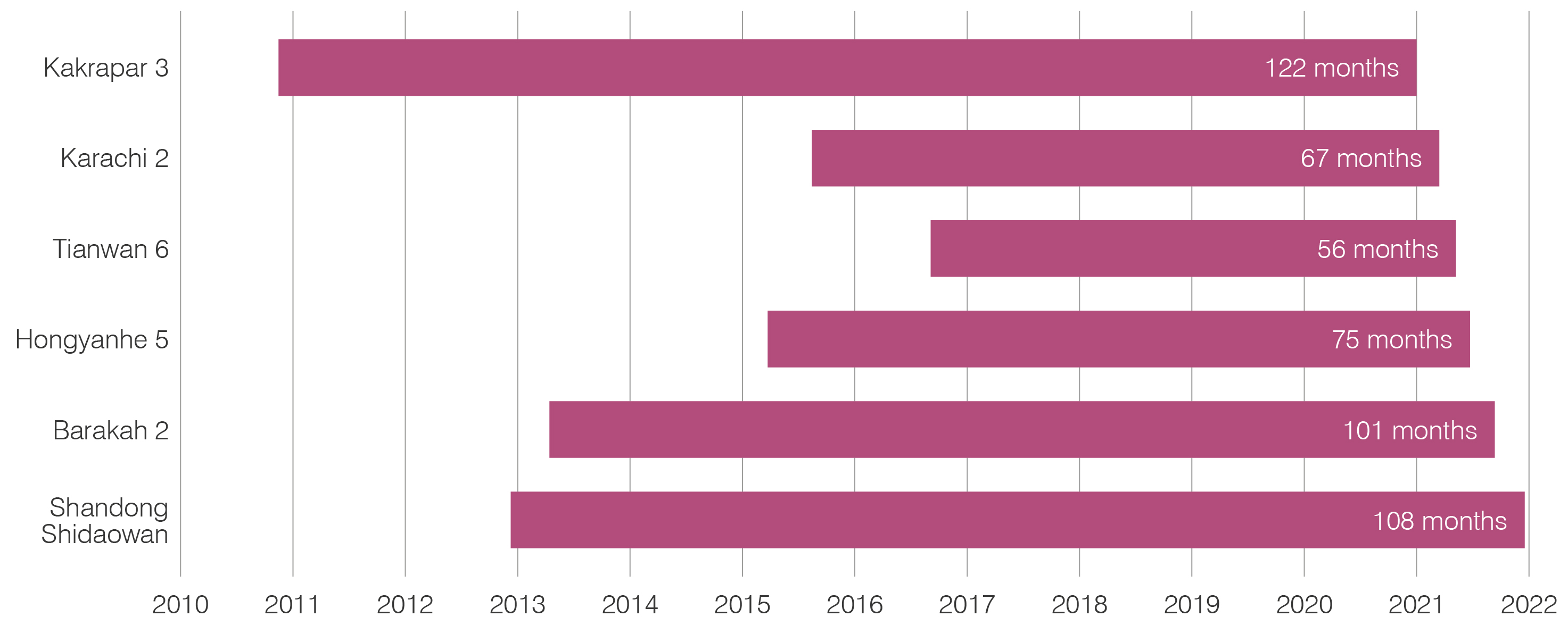
Source: World Nuclear Association, IAEA PRIS
The median construction time for reactors grid-connected in 2021 was 88 months, up slightly from the 84 months recorded in 2020.
Figure 11. Median construction times for reactors since 1981
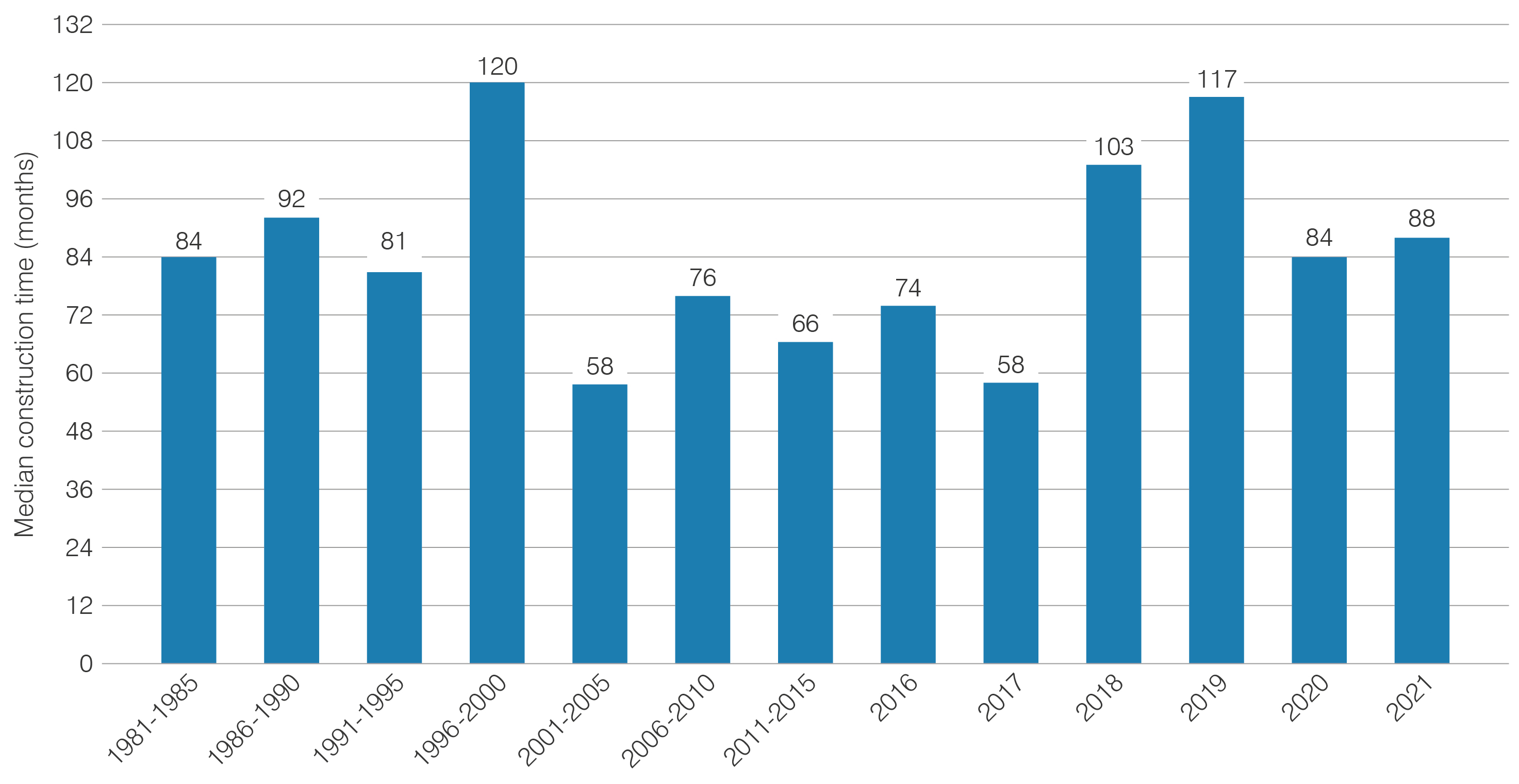
Source: World Nuclear Association, IAEA PRIS
Figure 12 shows the operational status of reactors constructed since 1986. Most reactors under construction today started construction in the last ten years. The small number that have taken longer are either pilot plants, first-of-a-kind (FOAK) reactors, or projects where construction was suspended before being restarted. In the case of Khmelnitski 3&4, Ukraine, two reactors that started construction in 1986 and 1987, there have been attempts to restart construction, but no active progress since 1990.
Figure 12. Operational status of reactors with construction starts since 1985 as of 1 January 2022
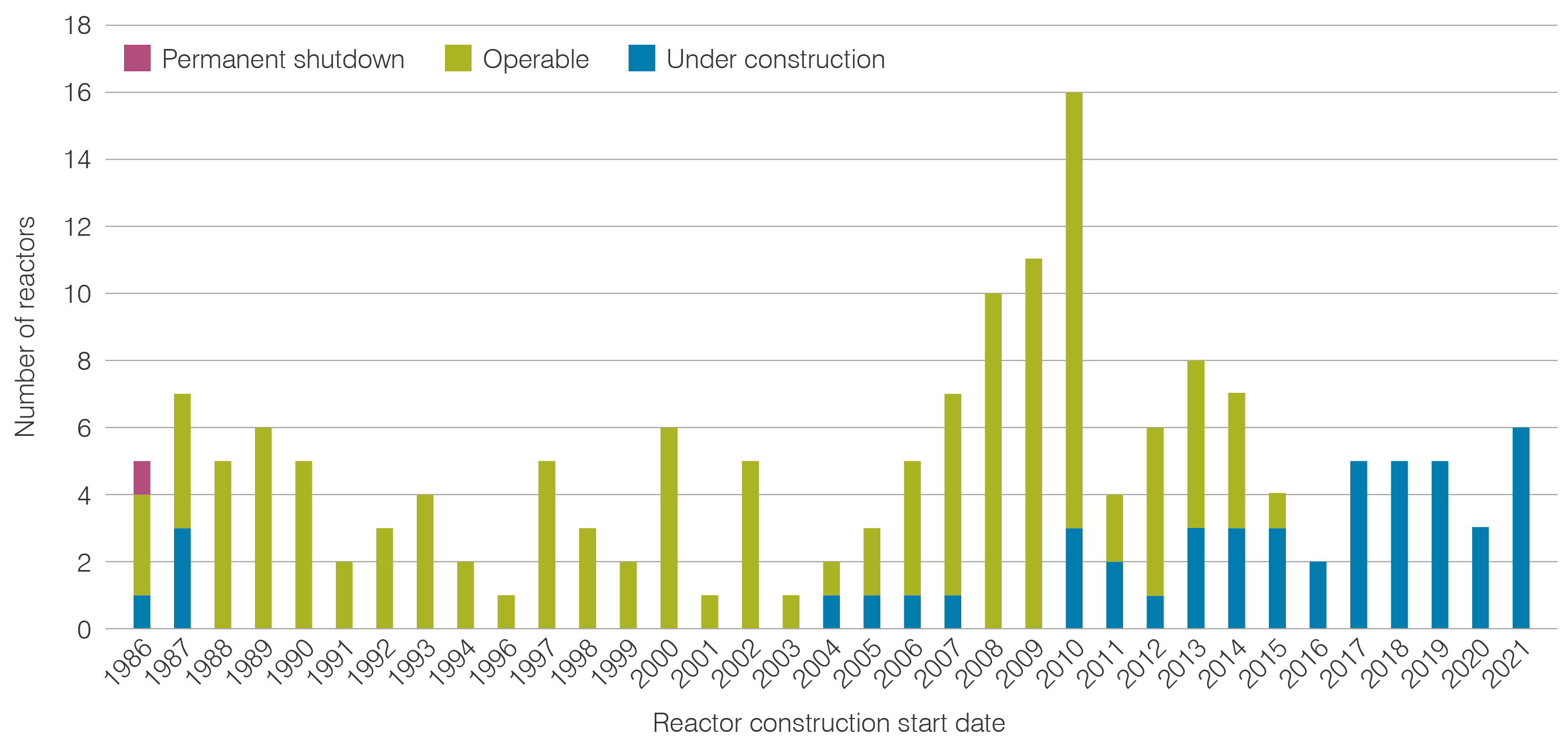
Source: World Nuclear Association, IAEA PRIS
Figure 13 shows the total capacity of reactors of different ages operating in any one year since 1970. As time passes those reactors that remain in operation move into the next category every ten years.
The total capacity of reactors that have been in operation for less than 10 years declined from around 1990, as the pace of new reactor start-ups slowed. With increased construction and subsequent commissioning of reactors in recent years the total capacity of reactors that have been in operation for less than 10 years has started to increase again.
Figure 13. Evolution of reactor ages
.jpg)
Source: World Nuclear Association, IAEA PRIS
Ten reactors were permanently shut down in 2021. The three German reactors and the one Taiwanese reactor were closed as a result of a political decision to phase out nuclear generation. The last three reactors in Germany are due to close in 2022.
Table 5. Shutdown reactors in 2021
|
|
Location
|
Capacity (MWe net)
|
First grid connection
|
Permanent shutdown date
|
|
Indian Point 3
|
USA
|
1030
|
27 April 1976
|
1 May 2021
|
|
Dungeness B1
|
UK
|
545
|
3 April 1983
|
7 June 2021
|
|
Dungeness B2
|
UK
|
545
|
29 December 1985
|
7 June 2021
|
|
Kuosheng 1
|
Taiwan
|
985
|
21 May 1981
|
1 July 2021
|
|
Karachi 1
|
Pakistan
|
90
|
18 October 1971
|
1 August 2021
|
|
Hunterston B1
|
UK
|
490
|
8 February 1976
|
26 November 2021
|
|
Kursk 1
|
Russia
|
925
|
19 December 1976
|
19 December 2021
|
|
Brokdorf
|
Germany
|
1410
|
14 October 1986
|
31 December 2021
|
|
Grohnde
|
Germany
|
1360
|
5 September 1984
|
31 December 2021
|
|
Gundremmingen C
|
Germany
|
1288
|
2 November 1984
|
31 December 2021
|
In 2021 six reactors were grid connected and 10 were permanently shut down. In terms of capacity, 5310 MWe was grid-connected and 8668 MWe was shut down.
Figure 14. Reactor first grid connection and shutdown 1954-2021
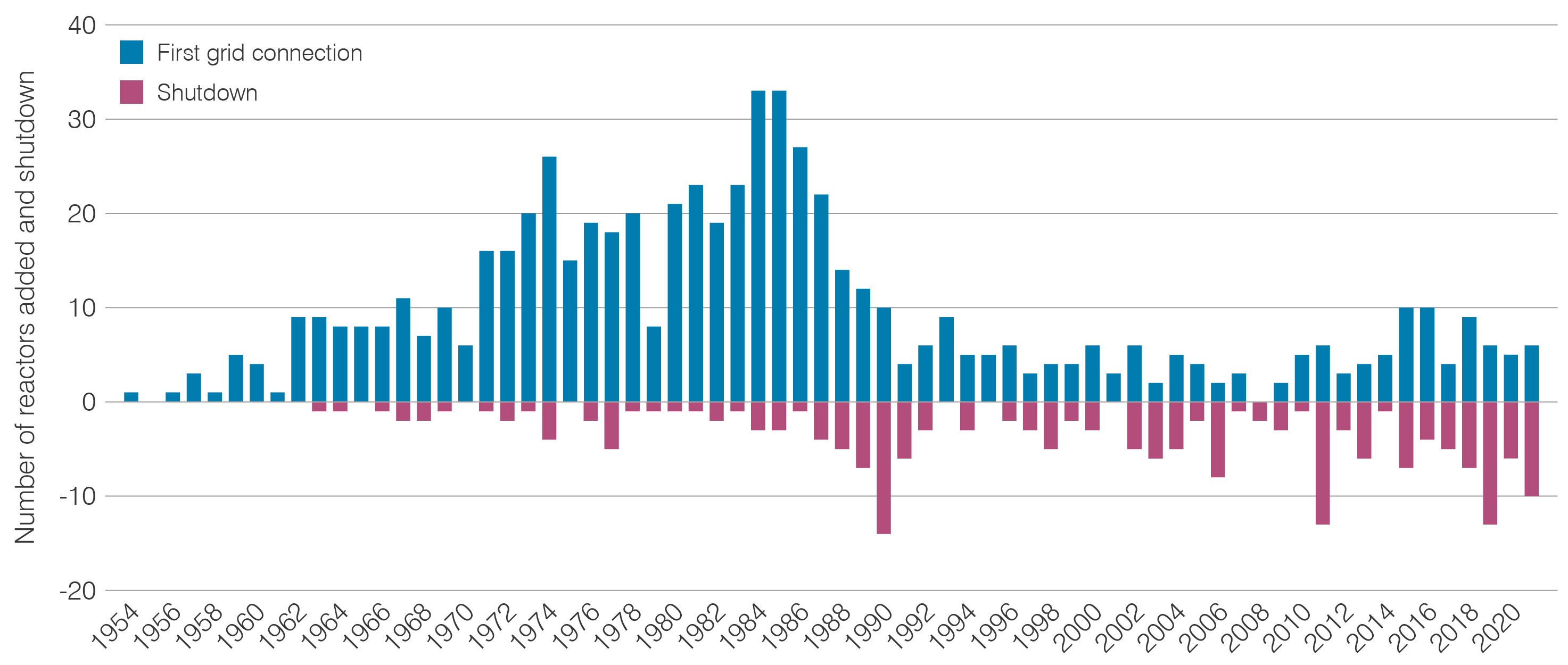
Source: World Nuclear Association, IAEA PRIS